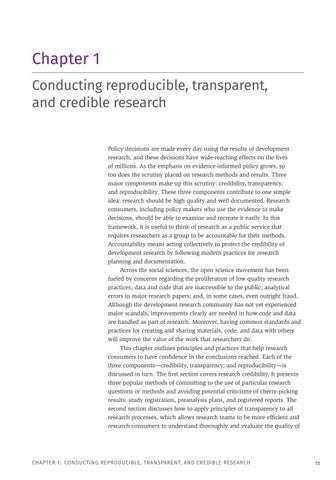Chapter 1 Conducting reproducible, transparent, and credible research Policy decisions are made every day using the results of development research, and these decisions have wide-reaching effects on the lives of millions. As the emphasis on evidence-informed policy grows, so too does the scrutiny placed on research methods and results. Three major components make up this scrutiny: credibility, transparency, and reproducibility. These three components contribute to one simple idea: research should be high quality and well documented. Research consumers, including policy makers who use the evidence to make decisions, should be able to examine and recreate it easily. In this framework, it is useful to think of research as a public service that requires researchers as a group to be accountable for their methods. Accountability means acting collectively to protect the credibility of development research by following modern practices for research planning and documentation. Across the social sciences, the open science movement has been fueled by concerns regarding the proliferation of low-quality research practices; data and code that are inaccessible to the public; analytical errors in major research papers; and, in some cases, even outright fraud. Although the development research community has not yet experienced major scandals, improvements clearly are needed in how code and data are handled as part of research. Moreover, having common standards and practices for creating and sharing materials, code, and data with others will improve the value of the work that researchers do. This chapter outlines principles and practices that help research consumers to have confidence in the conclusions reached. Each of the three components—credibility, transparency, and reproducibility—is discussed in turn. The first section covers research credibility. It presents three popular methods of committing to the use of particular research questions or methods and avoiding potential criticisms of cherry-picking results: study registration, preanalysis plans, and registered reports. The second section discusses how to apply principles of transparency to all research processes, which allows research teams to be more efficient and research consumers to understand thoroughly and evaluate the quality of
Chapter 1: Conducting reproducible, transparent, and credible research
11





